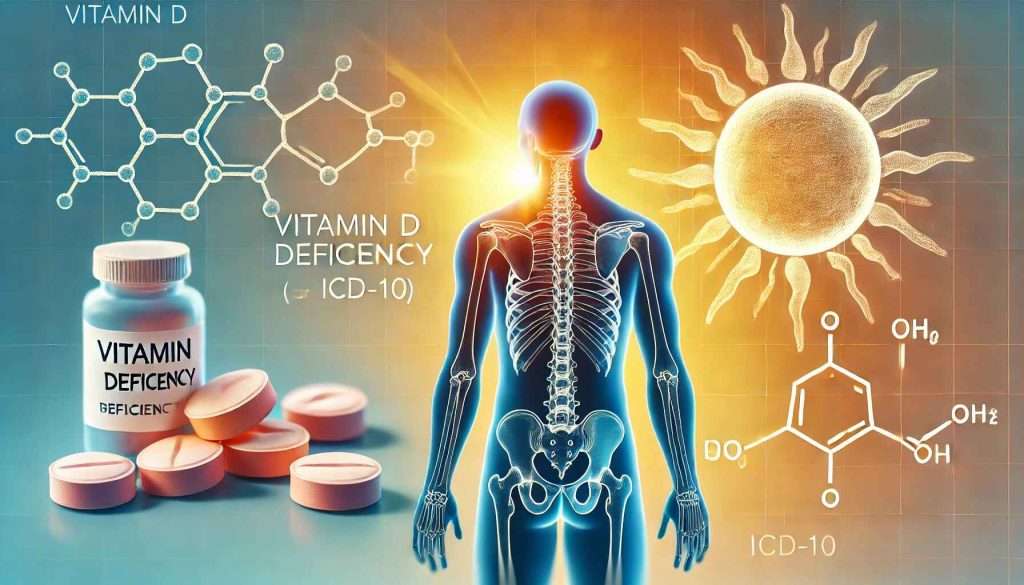Vitamin D Deficiency ICD-10: Understanding Its Significance and Implications

Vitamin D deficiency ICD-10 is a common health issue globally, affecting millions of people due to limited sun exposure, dietary insufficiencies, or medical conditions. The International Classification of Diseases, 10th Revision (ICD-10), assigns a specific code to this condition to streamline diagnosis, treatment, and medical record-keeping. This article delves into the details of vitamin D deficiency ICD-10, its ICD-10 code, its health implications, and the necessary steps for managing and preventing the condition.
What is Vitamin D Deficiency?
Vitamin D deficiency occurs when the body lacks sufficient vitamin D ICD-10 to maintain optimal bone health, immune function, and other vital physiological processes. Vitamin D, often called the “sunshine vitamin,” is crucial for calcium absorption, bone mineralization, and immune regulation.
ICD-10 Code for Vitamin D Deficiency
The ICD-10 code for vitamin D deficiency ICD-10 is E55.9. This code is used in medical records to indicate a confirmed diagnosis of vitamin D deficiency ICD-10 without specifying an underlying cause.
Additional Specific Codes
- E55.0: Rickets, active (a severe form of vitamin D deficiency ICD-10 seen in children causing bone deformities).
- E64.3: Sequelae of rickets (long-term effects of rickets).
These codes enable healthcare providers to document the condition accurately and guide appropriate treatment plans.
Causes of Vitamin D Deficiency
Vitamin D deficiency ICD-10 can result from various factors, including:
- Limited Sun Exposure
- Spending excessive time indoors.
- Living in high-latitude regions with limited sunlight.
- Wearing clothing that covers most of the skin.
- Dietary Insufficiency
- Lack of vitamin D-rich foods such as fatty fish, eggs, and fortified products.
- Medical Conditions
- Chronic kidney disease, liver disorders, or gastrointestinal conditions like celiac disease that impair vitamin D absorption.
- Age
- Older adults are at higher risk due to reduced skin synthesis of vitamin D.
- Skin Pigmentation
- Darker skin tones produce less vitamin D when exposed to sunlight.
- Obesity
- Vitamin D is fat-soluble and may become sequestered in fat tissue, reducing its bioavailability.

Symptoms of Vitamin D Deficiency
The symptoms of vitamin D deficiency ICD-10 can range from mild to severe, including:
- Bone Pain and Muscle Weakness
- Vitamin D is essential for bone health, and its deficiency can cause musculoskeletal discomfort.
- Frequent Infections
- A weakened immune system increases susceptibility to colds, flu, and other infections.
- Fatigue and Lethargy
- Low vitamin D levels can contribute to chronic fatigue.
- Mood Changes
- Deficiency is linked to depression and mood swings due to its role in serotonin regulation.
- Rickets in Children
- Softening of bones, delayed growth, and skeletal deformities.
- Osteomalacia in Adults
- Softening of bones causes pain and fractures.
Health Implications of Vitamin D Deficiency
1. Bone Disorders
- Osteoporosis: A long-term deficiency increases the risk of brittle bones and fractures.
- Rickets: Severe deficiency in children causes growth retardation and skeletal abnormalities.
2. Immune Dysfunction
Vitamin D modulates the immune system, and its deficiency can lead to a higher risk of autoimmune diseases and infections.
3. Cardiovascular Diseases
Low levels of vitamin D are associated with hypertension, heart disease, and other cardiovascular conditions.
4. Mental Health
vitamin D deficiency ICD-10 is linked to depression, anxiety, and cognitive impairments in older adults.
5. Chronic Diseases
Conditions like diabetes, multiple sclerosis, and certain cancers have been linked to inadequate vitamin D levels.
Diagnosis of Vitamin D Deficiency
Healthcare providers diagnose vitamin D deficiency ICD-10 through:
- Clinical Evaluation
- Assessing symptoms such as bone pain, fatigue, and frequent illnesses.
- Blood Tests
- Measuring serum 25-hydroxyvitamin D levels is the standard diagnostic test:
- Deficiency: <20 ng/mL
- Insufficiency: 21-29 ng/mL
- Sufficient: ≥30 ng/mL
- Bone Density Tests
- Used to evaluate bone health in severe cases or long-term deficiency.
Treatment of Vitamin D Deficiency
Treatment aims to restore optimal vitamin D levels through:
1. Supplementation
- Vitamin D2 (Ergocalciferol) or Vitamin D3 (Cholecalciferol) is prescribed.
- Dosage depends on severity:
- Mild Deficiency: 800-1,000 IU/day.
- Severe Deficiency: 50,000 IU/week for 6-8 weeks.
2. Sunlight Exposure
- Regular exposure to sunlight for 10-30 minutes a day on bare skin can help increase vitamin D levels.
3. Dietary Changes
- Incorporate vitamin D-rich foods such as:
- Fatty fish (salmon, mackerel).
- Egg yolks.
- Fortified dairy and plant-based milk.
- Mushrooms exposed to sunlight.
4. Addressing Underlying Conditions
- Treat medical conditions like malabsorption syndromes that contribute to deficiency.

Prevention of Vitamin D Deficiency
1. Balanced Diet
- Include foods naturally rich in vitamin D and fortified products in daily meals.
2. Regular Sun Exposure
- Spend time outdoors during peak sunlight hours, ensuring adequate skin exposure.
3. Vitamin D Supplements
- Use over-the-counter or prescribed supplements as needed, particularly in at-risk populations.
4. Routine Screening
- Regularly monitor vitamin D levels in high-risk groups, such as older adults, pregnant women, and individuals with chronic illnesses.
ICD-10 and Its Role in Managing Vitamin D Deficiency ICD-10
The ICD-10 code E55.9 plays a crucial role in:
- Standardizing Diagnoses
- Ensures consistent documentation across healthcare providers.
- Guiding Treatment Plans
- Helps tailor interventions based on the severity and cause of deficiency.
- Tracking Public Health Trends
- Facilitates the collection of data on vitamin D deficiency prevalence.
- Insurance and Billing
- Simplifies reimbursement processes for treatments and tests related to deficiency.
Challenges in Addressing Vitamin D Deficiency
- Lack of Awareness
- Many people are unaware of the risks and symptoms of deficiency.
- Limited Sunlight Access
- Urbanization and indoor lifestyles reduce opportunities for natural sunlight exposure.
- Dietary Limitations
- Vegetarian or vegan diets may lack adequate sources of vitamin D.
- Comorbid Conditions
- Chronic diseases complicate the absorption and metabolism of vitamin D.

Future Directions in Research
Emerging research focuses on:
- The role of vitamin D in preventing chronic diseases such as diabetes and cancer.
- Personalized medicine approaches to determine optimal vitamin D levels for individuals.
- Innovations in fortified foods and supplements to address global deficiency rates.
Conclusion
Vitamin D deficiency, coded as E55.9 in ICD-10, is a significant public health concern with far-reaching implications. Recognizing the causes, symptoms, and health risks associated with this condition is essential for timely diagnosis and intervention. Through lifestyle changes, dietary improvements, and medical care, vitamin D deficiency can be effectively managed and prevented.
Understanding the importance of vitamin D and leveraging tools like the ICD-10 coding system ensures better health outcomes and a comprehensive approach to this prevalent issue. With continued awareness and research, the burden of vitamin D deficiency can be significantly reduced worldwide.
















